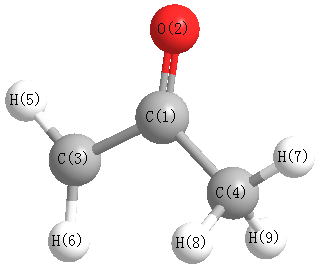Vibrational Frequencies calculated at TPSSh/6-31G*
| Mode Number |
Symmetry |
Frequency
(cm-1) |
Scaled Frequency
(cm-1) |
IR Intensities
(km mol-1) |
Raman Act
(Å4/u) |
Dep P |
Dep U |
|---|
| 1 |
A' |
3281 |
3148 |
7.09 |
|
|
|
| 2 |
A' |
3171 |
3042 |
13.33 |
|
|
|
| 3 |
A' |
3167 |
3038 |
2.93 |
|
|
|
| 4 |
A' |
3051 |
2927 |
6.16 |
|
|
|
| 5 |
A' |
1605 |
1540 |
55.45 |
|
|
|
| 6 |
A' |
1512 |
1451 |
13.08 |
|
|
|
| 7 |
A' |
1492 |
1431 |
18.92 |
|
|
|
| 8 |
A' |
1421 |
1363 |
20.51 |
|
|
|
| 9 |
A' |
1280 |
1228 |
60.80 |
|
|
|
| 10 |
A' |
1077 |
1033 |
4.90 |
|
|
|
| 11 |
A' |
932 |
895 |
4.55 |
|
|
|
| 12 |
A' |
819 |
785 |
2.52 |
|
|
|
| 13 |
A' |
511 |
490 |
14.44 |
|
|
|
| 14 |
A' |
370 |
355 |
1.89 |
|
|
|
| 15 |
A" |
3112 |
2985 |
16.38 |
|
|
|
| 16 |
A" |
1520 |
1458 |
7.31 |
|
|
|
| 17 |
A" |
1034 |
992 |
5.43 |
|
|
|
| 18 |
A" |
735 |
705 |
31.44 |
|
|
|
| 19 |
A" |
496 |
476 |
0.99 |
|
|
|
| 20 |
A" |
365 |
350 |
0.00 |
|
|
|
| 21 |
A" |
57 |
55 |
0.01 |
|
|
|
Unscaled Zero Point Vibrational Energy (zpe) 15503.3 cm
-1
Scaled (by 0.9594) Zero Point Vibrational Energy (zpe) 14873.9 cm
-1
See section
III.C.1 List or set vibrational scaling factors
to change the scale factors used here.
See section
III.C.2
Calculate a vibrational scaling factor for a given set of molecules
to determine the least squares best scaling factor.
Charges, Dipole, Quadrupole and Polarizability
Charges from optimized geometry at TPSSh/6-31G*
Charges (e)
| Number |
Element |
Mulliken |
CHELPG |
AIM |
ESP |
| 1 |
C |
0.444 |
|
|
|
| 2 |
O |
-0.446 |
|
|
|
| 3 |
C |
-0.353 |
|
|
|
| 4 |
C |
-0.571 |
|
|
|
| 5 |
H |
0.196 |
|
|
|
| 6 |
H |
0.176 |
|
|
|
| 7 |
H |
0.195 |
|
|
|
| 8 |
H |
0.179 |
|
|
|
| 9 |
H |
0.179 |
|
|
|
Electric dipole moments
Electric dipole components in Debye
(What's a Debye? See section
VII.A.3)
| |
x |
y |
z |
Total |
| |
-1.359 |
-2.531 |
0.000 |
2.873 |
| CHELPG |
|
|
|
|
| AIM |
|
|
|
|
| ESP |
|
|
|
|
Electric Quadrupole moment
Quadrupole components in D Å
Polarizabilities
Components of the polarizability tensor.
Units are
Å
3 (Angstrom cubed)
Change units.
| |
x |
y |
z |
| x |
5.948 |
0.278 |
0.000 |
| y |
0.278 |
5.671 |
0.000 |
| z |
0.000 |
0.000 |
3.096 |
<r2> (average value of r
2) Å
2
| <r2> |
76.932 |
| (<r2>)1/2 |
8.771 |
